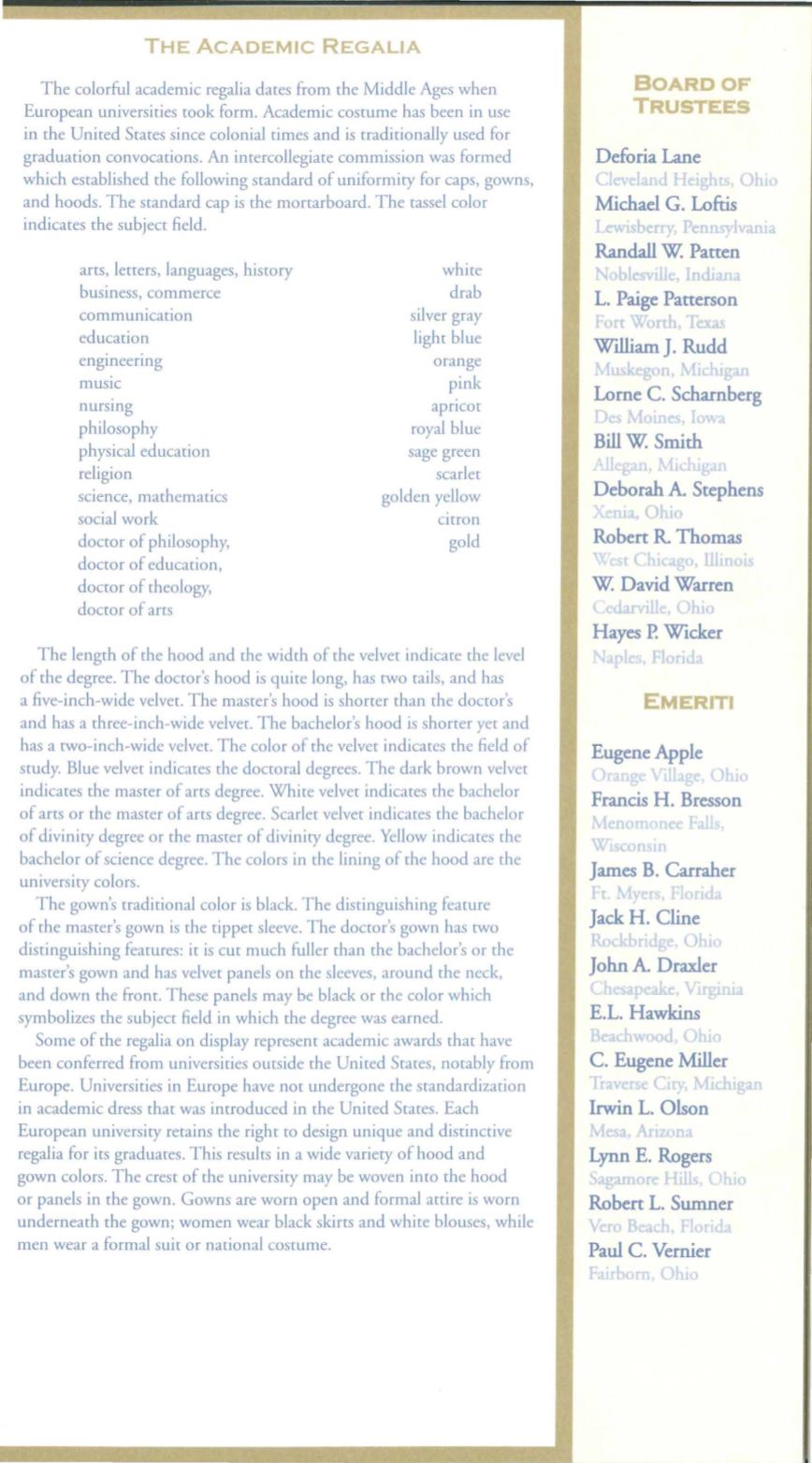

I
THE ACADEMIC REGALIA
The colorful academic regalia dates from the Middle Ages when
European universities took form. Academic costume has been in use
in the United States since colonial rimes and is traditionally used for
graduation convocations.
An
intercollegiate commission was formed
which established the following standard of uniformity for caps, gowns,
and hoods. The standard cap is the mortarboard. The tassel color
indicates the subject field.
arts, letters, languages, history
business, commerce
communication
education
engmeenng
music
nursmg
philosophy
physical education
religion
science, mathematics
social work
doctor of philosophy,
doctor of education,
doctor of theology,
doctor of arts
white
drab
silver gray
light blue
orange
pink
apricot
royal blue
sage green
scarlet
golden yellow
citron
gold
The length of the hood and the width of the velvet indicate the level
of the degree. The doctor's hood is quite long, has rwo tails, and has
a five-inch-wide velvet. The master's hood is shorter than the doctor's
and has a three-inch-wide velvet. The bachelor's hood is shorter yet and
has a rwo-inch-wide velvet. The color of the velvet indicates rhe field of
study. Blue velvet indicates the doctoral degrees. The dark brown velvet
indicates the master of arts degree. White velvet indicates the bachelor
of arts or the master of arts degree. Scarlet velvet indicates the bachelor
of divinity degree or the master of divinity degree. Yellow indicates the
bachelor of science degree. The colors in rhe lining of the hood are the
university colors.
The gown's traditional color is black. The distinguishing feature
of the master's gown is the tippet sleeve. The doctor's gown has rwo
distinguishing features: it is cut much fuller than the bachelor's or the
master's gown and has velvet panels on the sleeves, around the neck,
and down the front. These panels may be black or the color which
symbolizes the subject field in which the degree was earned.
Some of the regalia on display represent academic awards that have
been conferred from universities outside the United Stares, notably from
Europe. Universities in Europe have nor undergone the standardization
in academic dress that was introduced in the United States. Each
European university retains the right to design unique and distinctive
regalia for its graduates. This results in a wide variety of hood and
gown colors. The crest of the university may be woven into the hood
or panels in the gown. Gowns are worn open and formal attire is worn
underneath the gown; women wear black skirts and white blouses, while
men wear a formal suit or national costume.
BOARD OF
TRUSTEES
Defaria Lane
IO
Michael G. Loftis
a
Randall
W Patten
L. Paige Patterson
William J. Rudd
Lorne
C.
Scharnberg
Bill W Smith
Deborah
A.
Stephens
Robert
R
Thomas
W David Warren
Hayes
P.
Wicker
EMERITI
Eugene Apple
Francis H. Bresson
James B. Carraher
Jack H. Cline
John
A.
Draxler
E.L. Hawkins
C.
Eugene Miller
'l
Irwin L. Olson
Lynn E. Rogers
Robert L. Sumner
Paul
C.
Vernier














